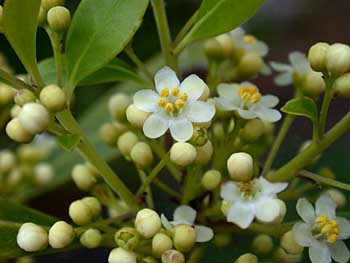We've been going by the habitat restoration regularly to check on our planting. We're now sure it is the deer that have been pulling over our cages intended to protect the trees and shrubs. A fellow who lives across the street and helps us put the cages back up told us he sees them do it. The deer regularly visit him, snacking on everything in sight. There are two young'uns and a doe with a limp.
There are 6 Ilex glabra (meaning smooth, related to the leaf surface) in the planting, a native holly with several regional names, including inkberry, Appalachian tea, dye-leaves, evergreen winterberry, and gallberry (the source of gallberry nectar honey, popular in the plant's southern range). Native to the eastern and south-central parts of the country especially along the coastal plains, it is one of the very few evergreen shrubs (broadleaf or narrowleaf) that thrive in acidic wet sites, but it will adapt to various soil pHs as well as dry soils. It is noted for its evergreen foliage and upright, spreading, and suckering shrub growth habit when in species form, but the compact cultivars serve as an alternative to boxwood in situations where a refined but taller and faster growing broadleaf evergreen is needed and an alternative to Japanese holly when a more cold-hardy broadleaf evergreen is needed.
In addition to being an excellent shrub for naturalized and wet areas, Ilex glabra functions well for foundations, borders, group plantings, mass plantings, formal or informal hedges, backgrounds, or specimens. It takes well to shearing, an asset for a shrub that otherwise has a tendency to legginess, and is adaptable to full sun or full shade. The foliage has a fine texture and thick density until maturity, when it may become average to open in its density unless it has been periodically sheared.
The flowers are insignificant, well-hidden among the dense foliage. The fruit is a drupe*, green maturing to reddish, then to inky black, whence the common name. Unsheared, the shrub may grow to 5-10', but may be maintained at any desired height by shearing any time of year.
 Inky black berries
Inky black berries |
| Dense evergreen foliage |
 There may be 5-7 petals
There may be 5-7 petalsAnother desirable feature of this extremely adaptable shrub is its resistance to deer damage. Although no plant is deer proof, plants in the Rarely Damaged, and Seldom Severely Damaged categories would be best for landscapes prone to deer damage. Plants Occasionally Severely Damaged and Frequently Severely Damaged are often preferred by deer and should only be planted with additional protection such as the use of fencing, repellents, etc. Success of any of these plants in the landscape will depend on local deer populations and weather conditions. Ilex glabra is is the Seldom Severely Damaged category. If your garden is plagued by deer, you can look for plants that will best meet your needs at the very useful site http://njaes.rutgers.edu/deerresistance/. A final reason for planting Ilex glabra: It is threatened in Maine, New York, and Connecticut and considered extirpated in the state of Pennsylvania.
*A fruit with an outer fleshy part surrounding a pit or stone with a seed inside. Examples are peach, apricot, mango, olive, coffee, most palms, pistachio, cherry, plum, and almond. Brambles such as blackberry and raspberry are aggregate fruits composed of clusters of drupelets. If the fleshy outer part of a drupe is actually dry or fibrous, such as the coconut, it is called a husk, and the fruit is classified differently. In the case of mulberries, their multiple, not aggregate fruits are actually derived from bunches of catkins (flower clusters), each drupelet thus belonging to a different flower.
No comments:
Post a Comment